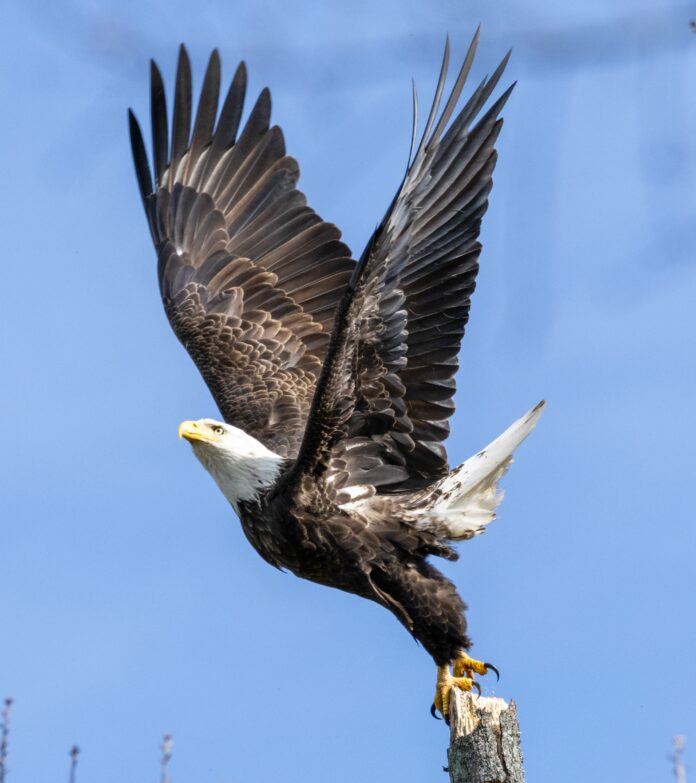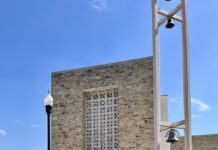MONTGOMGERY, Ala. – About 50 years ago, only 480 nesting pairs of bald eagles were left in the United States, with the last nest in Alabama documented in 1962. Thankfully, a great deal has changed since then, and so many eagles winter in our state that the Alabama Department of Conservation and Natural Resources (ADCNR) has a hard time counting them.
To celebrate the remarkable recovery of our nation’s emblem, Alabama State Parks will again host Eagle Awareness Weekends at Lake Guntersville State Park. The three-day 2023 events are scheduled for Jan. 20-22, Jan. 27-29 and Feb. 3-5.
Greg Lein, Alabama State Parks director, said packages are available for those who wish to attend the Eagle Awareness Weekends that include lodging, two breakfasts, one dinner, a welcome packet, VIP access to presentations from experts in eagles and other raptors, discounts at the restaurant and gift shop and photo excursions around one of Alabama’s most beautiful state parks. Lein suggests making reservations as soon as possible.
“Our lodge, campground, and chalets often fill up quickly for these weekends, so we encourage people to make reservations and join us at Lake Guntersville State Park for what we believe will be another amazing year of Eagle Awareness Weekends,” Lein said.
Eagle Awareness programs began in the mid-1980s at Lake Guntersville State Park. At that time, guests were only viewing eagles that had migrated from other states to Lake Guntersville for the winter months. Today, thanks to Alabama’s bald eagle restoration efforts, participants are viewing a mix of resident and nonresident eagles that are making use of the lake and forest habitats during the winter.
Mercedes Maddox, Nongame Biologist with the ADCNR’s Wildlife and Freshwater Fisheries (WFF) Division, is one of the presenters during the Eagle Awareness Weekends, and she said the statewide recovery of the bald eagle is an amazing story.
“Historically, we had a large population of eagles in Alabama, just like the rest of the U.S.,” Maddox said. “But as early as the late 1800s, that population started to decline. That was primarily due to human intervention in what some people perceived as a competition for food. They thought we were competing for the same food.”
The Bald Eagle Protection Act was passed in 1940 that provides criminal penalties for persons who “take, possess, sell, purchase, barter, offer to sell, purchase or barter, transport, export or import, at any time or any manner, any bald eagle … [or any golden eagle], alive or dead, or any part (including feathers), nest, or egg thereof.”
However, during World War II, the use of the pesticide DDT became widespread, which had devastating effects on fish and animal species, especially eagles. Maddox said the harmful effects of DDT weren’t realized for decades.
“It was viewed as this miracle insecticide,” she said. “Soldiers would spray it directly on their bodies. It was used for agricultural processes for insects eating crops. As DDT worked its way up the food chain, the concentrations became heavier and heavier. By the time it made to the top of the food chain, it was having direct and indirect impacts on bald eagles. One of the things it caused was the eagles’ eggshells to thin. They would lay the eggs, but when they sat on the nest to incubate them, the eggs would crack and never hatch. The eagles were building nests, laying eggs and producing no young.”
DDT was banned in 1972, but by that time, the eagle population had plummeted to about 1,000 birds. The U.S. Fish and Wildlife Service listed bald eagles as endangered in 1967.
The WFF’s Nongame Wildlife Program started in 1982 and became part of a multi-state effort in the Bald Eagle Restoration Program in 1984.
“We used a technique called hacking to grow the bald eagle population,” Maddox said. “Hacking is where biologists force an immature bird to take its first flight in a desired area. They would take eaglets from Florida and Alaska and release them in specific locations with depleted populations. The goal was for the eagles to imprint on those areas and return when they became sexually mature.”
Alabama has six hacking towers, one in north Alabama, four in the central part of the state and one in south Alabama. The first eagle taking flight from one of the hacking towers occurred in 1985 at Lake Guntersville. Maddox said Alabama participated in the hacking program until 1992. During that time, 91 eagles were released from hacking towers throughout the state.
“There was a nest attempt in 1987, but the first successful nest occurred in 1991,” she said. “That was the first successful nest in 30 years. It was a huge, huge success for the program as a whole. At that time, there were so few, we were able to do statewide nest surveys.”
When the aerial surveys were discontinued in 2006, Maddox said that 77 nests were known to be in Alabama and that successful nesting activity has continued to increase.
“You can now find eagles in every single county,” she said. “It’s so great talking to people, and they tell us, ‘When I was growing up, we never saw an eagle, but now I see them all the time.’ That just goes to show you the success story in Alabama and being a part of that.”
Alabama’s restoration program was funded through the Pittman-Robertson Act, which levies an excise tax on firearms and ammunition that is apportioned to state wildlife agencies for conservation efforts, hunter education programs and the operation of archery and shooting ranges.
“We do some aerial surveys, but we don’t do statewide surveys because there are so many nests that we can’t keep up with them,” Maddox said. “We fly along the Tennessee River every year to count eagles and look for nests. There is a huge concentration of eagles along the Tennessee River.
“It is one of the top recovery stories in the nation, I would say. I will be talking about the history of bald eagles at Lake Guntersville. It’s an exciting story to tell.”
While most of the focus has been on the bald eagle, Maddox also pursues research on the golden eagle.
“A lot of people don’t know we have golden eagles that winter in Alabama,” she said. “The Golden Eagle Project began about 10 years ago. It’s a multi-state project as well, as with any good conservation effort. So, partners are heavily involved in this. We use simple game cameras to monitor where eagles are occurring throughout the state. We’ve set up cameras at 21 different locations during the program. We’ve had golden eagle sightings at 10 locations, with the most southern location at Upper State Special Opportunity Area near Jackson. That was around Christmas in 2020, so that was a special Christmas gift. The areas where we consistently see golden eagles are Skyline, Freedom Hills and Oakmulgee wildlife management areas (WMAs) and the Talladega National Forest.”
Maddox said several golden eagles have been captured and fitted with transmitter tags to track their movement to determine migration pathways and habitats the eagles are accessing in Alabama. She said 19 tags have been attached since 2013 and six are still active.
“One of those tags still active is on a bird we’ve named Natchez, a bird that was captured at Freedom Hills,” she said. “She travels from way up in Canada near Hudson Bay. Other birds migrate to northern parts of Ontario, and others go to Newfoundland. They migrate a long way to get to Alabama every winter.”
Maddox said people will often confuse golden eagles with immature bald eagles, which have not developed the telltale white heads. Several tips can help the casual observer determine the species encountered, according to Maddox.
“Golden eagles are most often found in forested areas,” she said. “They feed on carrion, which is one of their primary food sources in the winter, but they also feed on small mammals.
“Bald eagles are found around water because they primarily feed on fish. So, if you see a large brown bird flying over the water and trying to capture a fish, it’s probably a juvenile bald eagle, especially if you see it during the summer. Bald eagles can be seen feeding on roadkill, but you’ll most likely see them by the water, trying to capture fish.”
Because the statewide aerial surveys have been discontinued, Maddox said WFF depends on the public to report eagle sightings and nesting activity.
Email mercedes.maddox@dcnr.alabama.gov to report any eagle activity or possible violations of the Bald Eagle Protection Act, which was amended to include golden eagles.
For more information about the Eagle Awareness Weekends at Lake Guntersville State Park, email indya.guthrie@dcnr.alabama.gov.































